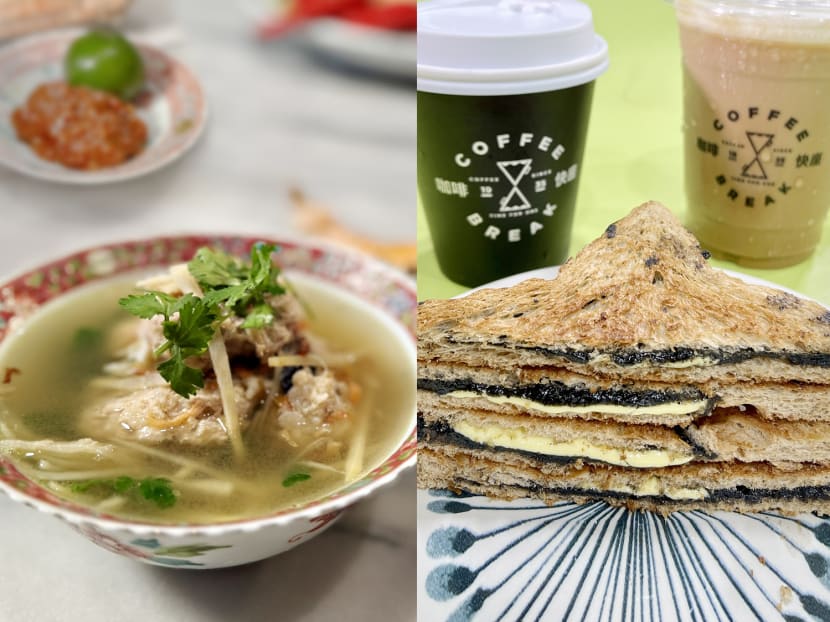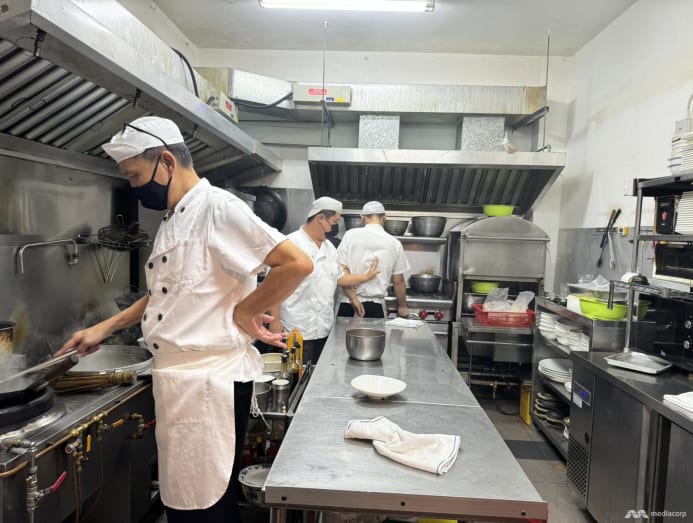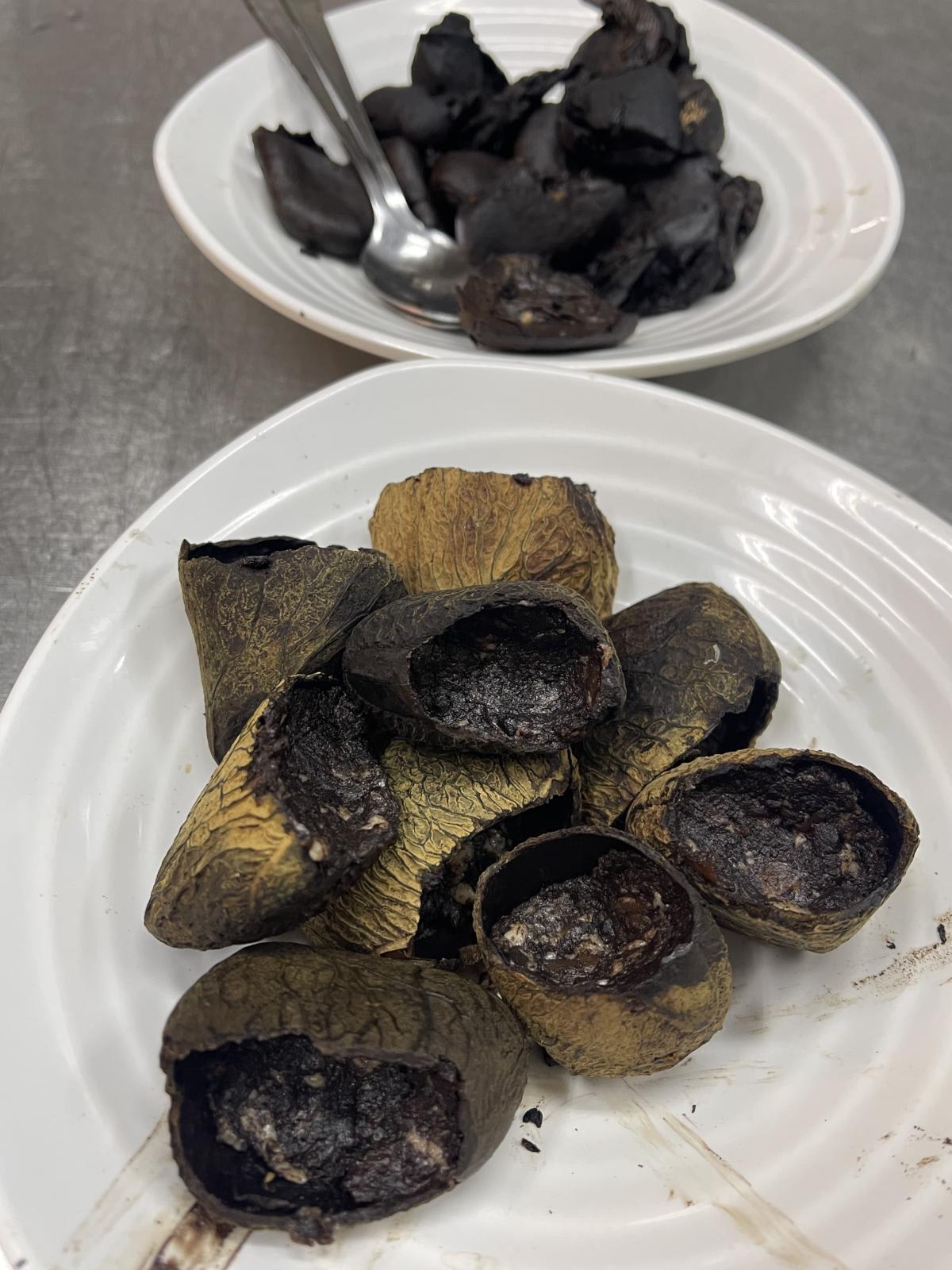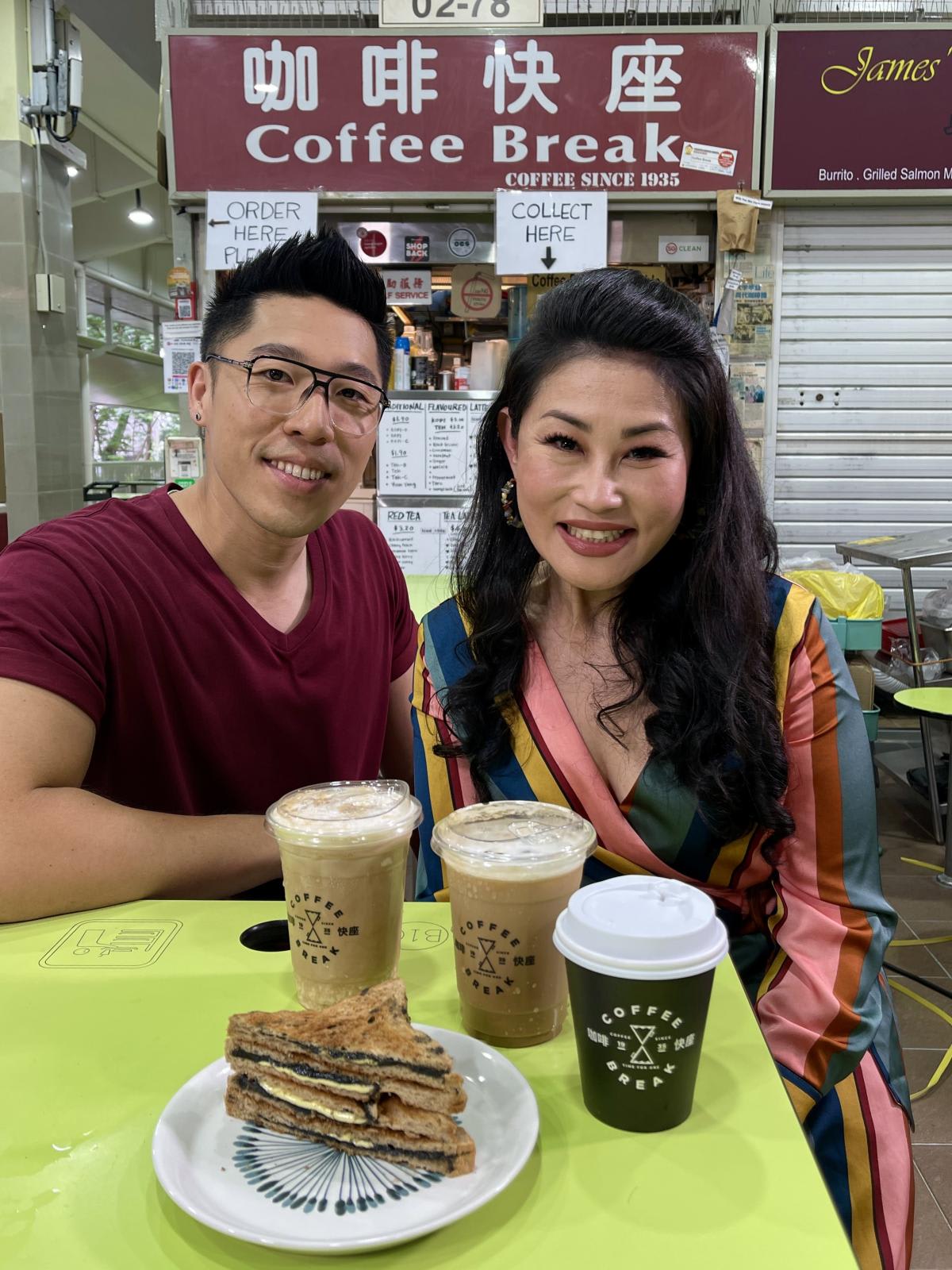What do Singapore’s oldest Peranakan restaurant and an Amoy Street kopi stall have in common?
Mediacorp Gold 905 DJ Denise Tan visits Guan Hoe Soon and Coffee Break to learn about the Hainanese connection.

Bakwan kepiting from Guan Hoe Soon (left) and coffee and sandwiches from Coffee Break. (Photos: Mediacorp, Denise Tan)

This audio is AI-generated.
The Hainanese community is renowned for its role in Singapore’s food history. From immigrants who found a niche in the service sector as restaurant cooks and domestic help in wealthy European and Peranakan households, they eventually set up their own restaurants in the post-War years. In fact, Singapore’s kopitiam culture has been largely attributed to the Hainanese.
It was no coincidence then, that my Makan Kaki Chef Melvyn Lee had arranged visits to two family businesses that are thriving examples of that delicious Hainanese heritage: Coffee Break and Guan Hoe Soon.
Both are currently in the hands of third generation owners – one steeped in the aforementioned kopi culture, the other a restaurant born of Peranakan-influenced Hainanese enterprise.
GUAN HOE SOON
The latter was a surprise discovery. Guan Hoe Soon is known for its Straits-Chinese cuisine, but I never knew that it had Hainanese roots. Founded in 1953 by Yap Chee Quee and allegedly the oldest of its kind in Singapore, the restaurant is still family owned and run. His granddaughter Jenny Yap, and her husband Raymond Ou Yong have been the gatekeepers of the family’s culinary history for the last 34 years.

“My grandfather came from China, Hainan Island. He worked as a housekeeper in a Peranakan family. Later, when he saved enough money, he started his own coffeeshop to make Peranakan food in the Joo Chiat area,” Jenny shared.
The restaurant name, Guan Hoe Soon, is an amalgamation and declaration of fatherly pride. Jenny explained: “My Ah Gong’s three sons’ names. Ah Guan, Ah Hoe, Ah Soon.” Her heritage emblazoned across its signboards, Jenny has been involved in the family business since she was 17 years old.
“I started very young, when I finished my O-Levels. My parents asked me to come back and join the restaurant,” said Jenny, who eventually married a man committed to carrying on her family’s food legacy. Her husband Raymond is now the head chef of Guan Hoe Soon – and even Ah Gong’s treasured recipes have been entrusted to him.

Surprisingly, Chef Raymond didn’t come from a culinary background. “I was in the forces, the navy, in the mechanical engineering side. And after I met my wife, I realised she’s running F&B. After the second week, I was told to come and work here. So from there, I picked up the trade,” revealed Chef Raymond, who took eight years to perfect the family’s heirloom recipes.
He put us to work, scooping out the contents of keluak nuts with the handle of a spoon. “It’s very expensive nowadays. The price went from 60 cents per kg to now, six dollars. When there’s demand, the price will increase,” he said.

No wonder many refer to it as “black gold”. The poisonous nut is also infamously laborious to prepare and requires an experienced touch to rid it of toxins. The traditional process of treating the nuts is to bury them in volcanic soil for three days.
“You have to soak it for three, four days. This was in the early days but now after nearly 10 years, I cut the process short by boiling it three times. Immediately afterwards, you cut it so that the water will not seep in and it will be very nice,” Chef Raymond disclosed.
Once we had harvested enough “black gold”, we mixed in fish and pork that had been minced in-house, then stuffed the paste back into clean buah keluak shells. Even this required technique and skill. Using our fingers to press and smear firmly, we had to ensure the stuffing was smoothly sealed in.
“You can’t put too much. If you don’t push it in, it will drop out when you cook,” Chef Raymond explained. The stuffed nuts were a key component of ayam buah keluak. Cooked together with chicken pieces and a specially blended rempah (spice paste) the iconic Peranakan dish was a study in complexity. Bringing out depth of flavour required experience, careful adjustments and time.
“Agak agak (estimate in Malay)! Like what the Chinese say, you’ve got to use your ‘wu guan’, five senses,” he told us sagely.

Our work in the kitchen was rewarded with a dish of nuanced flavours. The buah keluak lent a deep, pungent earthiness to the gravy, its mysterious flavours fully absorbed by savoury, tender chicken pieces. Combined with lush smears of the buah keluak stuffing on white rice, my “wu guan” were sent into overdrive. I especially liked that the gravy was lighter and tangier than I was used to. Tamarind and lemongrass gave it a refreshing zing to balance the bittersweet, almost muddy taste of the buah keluak.
Chef Melvyn and I swiftly powered through a feast of other dishes including udang nanas pedas, Nyonya chap chye, otak-otak and, my favourite, bakwan kepiting. Named for its ingredients – bakwan means meatball in Chinese and kepiting means crab in Malay – the hand-shaped spheres of minced pork and crab meat were served in a piping hot broth. The crab was sweet and fresh, whilst a generous fat to meat ratio gave the bakwan a luscious texture. Slivers of shitake mushroom, carrot and bamboo shoots added bite to the tender meatballs.

Jenny urged us to dip them in spicy, umami homemade sambal belacan, which skyrocketed the dish to tasty new heights. I slurped the comforting surf and turf soup down to the last drop. A rare treat, since my family only enjoys homecooked bakwan kepiting during Chinese New Year.
Chef Melvyn was partial to the chap chye because he remembers meals at Guan Hoe Soon with his grandfather. The braised vegetable stew of cabbage, beancurd skin, shitake and wood ear mushrooms with lots of tau cheo (salted, fermented soya bean paste) contained the most potent ingredient of all: Nostalgia.

“My grandpa always ordered the chap chye. That’s his favourite. Being a kid last time, tasting it, and now being a grown man, it tastes the same. So this is a very powerful thing with food, that you can bring somebody back in time,” he said.
I couldn’t have agreed more. As we cooled our spice-torched tastebuds with cendol (chen dool on Guan Hoe Soon’s menu), it occurred to me that the dishes we had enjoyed were like edible time capsules, capturing the very essence of Jenny’s family history, a tale of tenacity, entrepreneurial spirit and culinary pride.

However, like so many heritage brands in Singapore, succession is a challenge. The future of Guan Hoe Soon is uncertain because Jenny and Raymond’s children have chosen to pursue other professional careers. So for now, Jenny does what she can to ensure each dish remains true to its roots.
“Now that I’m older, I’ve started to write down the recipes. So all my assistant chefs have to follow. In Peranakan food, you must not stinge on your ingredients. This is very important. You must use the freshest ingredients to cook the food,” she said.
Spoken like my mother would. In truth, coming from a Peranakan family, I rarely dine out for Peranakan food, since I can have it at home. With their discerning palates, the bibik squad is ruthless and most restaurant dishes can never measure up to their own. Even with the inevitable chorus of critiques, Jenny is unflappable.

“I cannot say I can fulfil a hundred percent of all the Peranakan families, but I can fulfil at least 80 percent, which I’m very happy with already,” she shared humbly.
For me, partaking in her family’s brand of Peranakan food was not a matter of comparison. It was different, but no less delicious than my family’s. Case in point, our dessert.
Bright green squiggles of pandan-perfumed cendol (rice flour jellies) and plump red beans were laced with thick coconut cream, then topped with a globe of crushed ice. Top quality gula melaka that had been boiled for eight hours was the crowning touch. Deep caramel sweetness mingled with hints of salt from the coconut cream for a decadent end to our meal. With the knowledge that Guan Hoe Soon may not continue for another generation, I dug in with new-found urgency and appreciation.
COFFEE BREAK
The Sai siblings are another Hainanese family that has stepped up to the challenge of upholding tradition. But interestingly, their strategy as owners of Coffee Break is to modernise kopitiam culture. Chef Melvyn and I had lots to discuss with Jack and Anna Sai, who run their stall at Amoy Street Food Centre with their sister (Anna’s twin) Faye.

They can trace their F&B roots to their grandfather, who came to Singapore from Hainan Island in 1935 and opened a coffeeshop at the former Tanjong Pagar wharf. Several locations later, their father took over the stall and moved it from Boon Tat Street to their current premises in 1999.
As Jack tells it, the siblings have always had a hand in the family business, even when they were children. “We were the ones who came up with the name. One night while we were studying, my dad came into the room and he asked us, ‘guys, what should I name my stall?’”
Possibly needing respite from their schoolwork, they brainstormed and came up with “Coffee Break”. Although they went on to pursue separate careers – Jack as a freelance journalist for business magazines and Anna in early childhood education – the siblings eventually found their way back and breathed new life into the family trade.
At Coffee Break, you’ll find what hipster cafes are offering but in a hawker centre setting. So expect specialty coffee concoctions and unusual sandwich spreads besides more traditional breakfast offerings like kopi and kaya toast. Taro, mango milk, caramel rum and hojicha were a few flavours that stood out. An intriguing array of kopi, teh, latte and mocha variations, including non-dairy, decaf, yoghurt and cheese mousse topping options beckoned.
While the siblings certainly have updated the Coffee Break menu, Jack credits their father for being an early innovator. “My dad was the one who first started introducing flavours like hazelnut kopi, Irish cream kopi, caramel kopi, so he was the OG of all our newfangled flavours,” he said.

Easing us into a selection of their bestsellers, Anna started us off with their sea salt caramel iced latte. “We put real sea salt in the coffee and add a little bit of caramel,” she explained.
The result was as described – a crowd-pleasing savoury-sweet treat for a hot day. Next came the kopi-o kosong with cream mousse, a beverage topper more commonly found at bubble tea shops. It tasted much like kopi-c, the cloud-like mousse layer infusing the drink with a fuller, thicker milkiness.
Traditionalists need not worry though. A whole section of the menu is reserved for local Nanyang-style kopi and teh without the bells and whistles. We couldn’t get more traditional than kopi gu you (Hokkien for butter coffee), which has been served in kopitiams since the 1930s, preceding the low-carb, keto bulletproof coffee trend by decades. Favoured in the past by labourers who relied on the high calorie beverage for sustenance, Coffee Break serves theirs with butter on the side so customers can enhance their coffee to their liking.
“Some people like to give it a good stir, some people like to just swig it once they put the butter in. It’s really up to personal preference,” Jack said.

Butter is also a preferred pairing with traditional kaya toast, but Coffee Break’s menu also includes cinnamon sugar and kueh salat (pandan and coconut) spreads with bread and butter. Chef Melvyn and I were delighted by their non-traditional black sesame toast – a customer favourite of crisp brown bread slathered in the eye-catching dark goo.
“We make it from scratch. It’s roasted black sesame with a little bit of sugar and we mix it with water till the consistency is right. Then we serve it with butter because it balances out the bitterness,” Anna shared.
The black sesame paste was full-bodied and nutty, with a delicate crunch. “The paste has a lot of texture because they use real good quality black sesame seeds, so you can still feel the husks,” Chef Melvyn described.
And just as Anna said, butter really made everything better. Each triangle of toast included a golden slab, melty on the outside and still creamy-cool on the inside.
Jack agreed: “Butter is magic.” Quite the culinary magician himself, Jack is responsible for their “second best-seller", Earl Grey creme toast. Flavoured tea leaves are steeped in non-dairy cream for two days to create the fragrant, fluffy spread.
Striking a balance between old and new was a steep learning curve for the siblings, but they now straddle both worlds with ease. To win over their dad’s regular customers, they’ve memorised their usual orders. And their novel specialty toasts are still made using an ingenious old-school invention – a battered spoon hammered flat for the spreads.
“It’s for wider surface area, so it’s more efficient,” Jack explained. "It’s a dad thing,” Anna added. Though semi-retired, the senior Sai “spot checks now and then” to make sure the stall is running as it should. "Quality control, definitely,” Jack confirmed, acknowledging the responsibility he and his sisters have taken on.
“I’m a coffee drinker as well as a tea drinker myself. So when I drank coffee from other coffeeshops, and even in cafes, I always found that there was something lacking and I guess, it’s just the taste of familiarity and the taste of home that made me really want to carry on this heritage that has been passed down from my grandfather to my father. I felt that it is a worthy endeavour,” he said.

In a landscape where many young F&B entrepreneurs are throwing in the towel, the talented trio are determined to keep their family legacy going. They have expanded the business to two other branches at Market Street and Hong Lim Food Centres. They have also created a takeaway line of instant coffee and tea flavours, roasted coffee beans and chilled bottled beverages, leveraging on social media and e-commerce platforms. Their dream is to keep growing their family brand.
"Yeah, we’ll have world domination as well,” Jack jested. “We are looking for potential franchisees who are keen on expanding this community that we have built over the years.”
The Sai siblings’ innovative drink flavours and toasts with a twist have attracted a new generation of customers, but their deep respect for their roots has retained the support of older patrons. Connecting the traditional with the contemporary, Coffee Break is indeed building community one cup at a time.
Guan Hoe Soon is located at 200 Joo Chiat Road, #01-01, Singapore 427471. It's open daily from 11 am to 3 pm for lunch; Mondays to Fridays from 5.30pm to 9 pm for dinner and weekends from 5pm to 9pm for dinner.
Coffee Break is located at Amoy Street Food Centre, 7 Maxwell Rd, #02-78, Singapore 069111. It’s open Mondays to Fridays from 7.30am to 2.30pm.
Catch Makan Kakis with Denise Tan every Thursday from 11am on Mediacorp GOLD 905.





